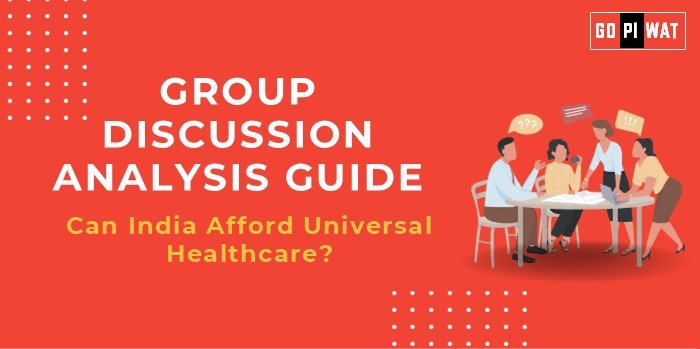📋 Group Discussion Analysis Guide: Can India Afford Universal Healthcare?
🌐 Introduction to Universal Healthcare in India
Opening Context: Universal healthcare (UHC) aims to provide equitable access to health services without financial hardship. For India, with its diverse socio-economic landscape, achieving UHC is both an ambitious goal and a pressing need.
Topic Background: While healthcare initiatives in India have improved access and affordability, UHC would require extensive government funding and a sustainable model. As India progresses toward economic growth and poverty alleviation, this discussion explores whether India can achieve UHC given its fiscal constraints and diverse needs.
📊 Quick Facts and Key Statistics
- Current Healthcare Spending: India spends around 1.28% of its GDP on healthcare, significantly lower than the global average of 6%.
- Out-of-Pocket Expenditure: Approximately 62% of healthcare costs in India are paid out-of-pocket, one of the highest globally.
- Healthcare Access: Only 28% of India’s rural population has access to healthcare within a 5 km radius.
- Global Benchmark: Developed nations with UHC spend at least 5-10% of their GDP on healthcare.
👥 Stakeholders and Their Roles
- Government: Setting policies, providing public healthcare funding, and ensuring infrastructure development.
- Private Sector: Private hospitals and clinics fill gaps in public healthcare and provide specialized treatments.
- NGOs: Facilitate community outreach, awareness, and access to healthcare in underserved areas.
- International Organizations: WHO, World Bank, and others support initiatives for strengthening India’s healthcare infrastructure.
🎯 Achievements and Challenges
- Achievements:
- Ayushman Bharat covers 500 million citizens, one of the world’s largest healthcare programs.
- Vaccination initiatives like Pulse Polio have eradicated diseases and improved life expectancy.
- Health outreach programs have reduced mortality rates and improved maternal health outcomes.
- Challenges:
- Limited healthcare expenditure relative to GDP.
- Infrastructure gaps in rural areas leading to disparities.
- Comparative analysis: Thailand’s UHC success vs. India’s fiscal constraints.
📚 Structured Arguments for Discussion
- Supporting Stance: “India’s UHC initiative can improve life expectancy, boost workforce productivity, and reduce poverty caused by health expenses.”
- Opposing Stance: “Given India’s fiscal deficit, UHC could be financially unsustainable, straining other development projects.”
- Balanced Perspective: “While UHC can drive equitable growth, a phased implementation with regional adaptations may be more feasible.”
🗣️ Effective Discussion Approaches
- Statistical Opening: “India’s healthcare spending at 1.28% of GDP is far below the 5% threshold needed for basic UHC.”
- Comparative Opening: “Thailand’s UHC model shows lower-income nations can achieve healthcare coverage with challenges in sustaining funding.”
- Case Study Opening: “Kerala’s healthcare system offers a successful localized model for UHC, but scaling it nationwide poses challenges.”
📈 Strategic Analysis of Strengths and Weaknesses
- Strengths: Expanding schemes like Ayushman Bharat, strong pharmaceutical industry, improving digital health infrastructure.
- Weaknesses: High out-of-pocket expenses, inadequate rural infrastructure, shortage of trained medical staff.
- Opportunities: Use of telemedicine, potential international funding, NGO collaborations.
- Threats: Rising medical costs, political instability, implementation challenges.
📌 Connecting with B-School Applications
- Real-World Applications: UHC discussions are pertinent for projects in healthcare management, public finance, and socio-economic policy analysis.
- Sample Questions:
- “How can India balance its budget while aiming for UHC?”
- “What are the economic impacts of UHC on labor productivity?”
- Insights for B-School Students: Explore economic trade-offs of UHC to build understanding in resource allocation and policy-making.


